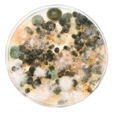
Occasionally concerned clients ask me if their instrument could be making them sick. Inevitably it follows a news story that has made the rounds on social media regarding conditions with catchy names like trombone lung, saxophone lung, or the most recent, bagpipe lung, which resulted in a confirmed fatality. These are all cases where lack of instrument cleaning created a favorable environment for various strains of fungi to flourish. The spores are then transferred to the respiratory system of the player, causing illness and occasionally permanent damage. The risk of mildew is less with flutes than some other instruments, but it still occurs enough that flutists should take precautions.
A Fungus Among Us
Mildew and mold fungi are constantly all around us. While beneficial and necessary for many natural processes, in high concentrations spores can be harmful. Many types of fungi require certain conditions of temperature, light and humidity to thrive. The inside of a wind instrument can provide ideal conditions for explosive growth.
Compared to other wind instruments, flutes have a much smaller degree of moisture flowing through the instrument. While the concentration of moisture is lower, it can still be enough for mildew to get a start. Dissolved sugars and minerals transported by the breath – the same compounds that can create sticky pads – are valuable nutrients for fungi. Additionally, the porous surfaces that are common in instruments and cases provide wonderful habitats for fungus.
A Bit about Biology
Mildew and mold have two components: a vegetative part and spores. The vegetative part is the organism that actively grows and can easily be taken care of by common cleaning solutions your technician uses. The spores are the reproductive part that are designed to spread on air currents and are revealed by a telltale old instrument smell. Every time you catch a whiff of that mustiness, you are inhaling many thousands of microscopic spores. Daily exposure to spores from a wind instrument is exponentially higher than from the normal environment. This can be a serious health hazard.
Fungal spores are one of the most perfect reproductive systems nature has devised. The spores have an outer casing that is incredibly tough. This shell can withstand extreme heat and cold, blasts of radiation, every over-the-counter cleaning product, and even the most blistering insults. Then after lying in wait for years or decades, when the right conditions exist, the spore can germinate. There are chemicals that can break down the outer shell but are so caustic or toxic they cannot be used safely on musical instruments. The only recourse with musical instruments is to remove all of the harmful spores from the equation.
Maintenance Concerns
In order to prevent fungus from getting a foothold, good maintenance practices such as making sure your mouth is clean before playing and swabbing out the instrument afterwards are crucial. Every wind instrument in regular use should be professionally cleaned at least every 12-18 months. There are things the player cannot and should not clean on their own. If an instrument is to be stored for a period of time, try to keep it in a place where the relative humidity is below 50%.
If the instrument or case gets wet, do not close it up or store it in a locker. This will guarantee a mildew problem. Instead find a safe place to set the instrument or case and arrange the wet pieces so that air can circulate around them. A low power fan will help. Refrain from using a hair dryer or other more aggressive applications of heat to the instrument. It is also a good idea to consult a technician right away to make sure there are no lingering issues.
The Smell Test
The easiest way to detect a possible mildew problem is the smell test. Musical instruments should not smell like anything. Different strains of mildew will carry different scents. Some take on a fruity or sweet aroma, while others are odorless. Most often, however, they will have a musty basement smell. An instrument does not have to be old to harbor a colony of fungus. Just a few instances of not swabbing adequately can provide the right conditions for a problem to develop. If your instrument or case has any lingering scent, consult a professional.
Allergies to mildew and mold are quite common. Be aware of physical reactions that accompany being in proximity of an instrument suspected of having a mildew problem. Symptoms can include a tickly throat, congestion, and headaches. Combine mildew allergies with asthma and the situation becomes dangerous. Even if you are not sensitive to the mold, it could cause serious issues for others who sit near you in rehearsal.
The Road to Recovery
A mildew infestation can be abated, but is very difficult. The microscopic spores grab on to soft surfaces quite easily, and removing them from materials such as felt, cork, or case lining fabric is extremely difficult. All of the soft materials must be removed from the equation. This usually means the remedy is an overhaul plus a new case. (Cases sometimes can be cleaned, but it is often cost prohibitive.) The porous materials need to be replaced and every square millimeter of the instrument’s surface needs to be scrubbed to make sure there are no spores left to continue their biological mission. In the instance of some student model instruments, it is possible for the mildew abatement to exceed the value of the instrument.
I sometimes hear people say, “it doesn’t smell too bad,” or “it’s always smelled like that.” Mildew is a biohazard and should not be accepted as normal. When your health or the health of a family member is at risk, having a job done right is very important. Find a technician who appreciates the seriousness of mildew. Vacuuming out the case, applying baking soda, or letting it sit in the sun are common quick fixes, but will not solve a persistent problem.
Mildew Tip No. 1
Do not use Febreze, Lysol, or other products to treat mildew yourself. It will not succeed, will allow spores to spread, and could damage your instrument.
Mildew Tip No. 2
Replace or launder your swab regularly. It could be the source of a mildew problem.
Mildew Tip No. 3
Be aware of messages from your body. Some mildew spores do not have a smell trigger but can still cause a reaction.
Mildew Tip No. 4
With a severe mildew problem, the case must be replaced at the same time the instrument is cleaned or the spores will persist.
Preventing Mildew
Swab after every use. Even if it is just playing for a few minutes during lessons, swab it out. It does not take much moisture to cause a problem.
Play with a clean mouth. No food or drink other than water while playing and at least rinse well beforehand. Dissolved sugars feed fungus.
Wet cases are serious. If your instrument or case gets wet, never close it up and trust it will be fine drying on its own.
Avoid cross-contamination. Do not transport a mildewed instrument in a clean case or vice versa, even just to the shop. Neither are clean after this happens.
Trust your nose (or a friend’s nose). Do not ignore an aroma in your case. It is easy to become desensitized so get a second opinion, or alert a colleague who may have mildew. Get it remedied before it becomes more serious. “Doesn’t bother me” is ignoring a biohazard.






